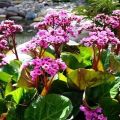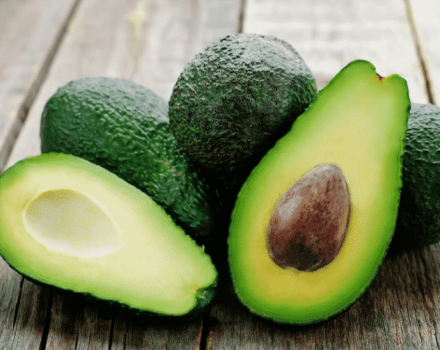16 varieties and types of badan with a description, planting and care rules
For landscaping garden plots, herbaceous shrubs are increasingly used. One of the demanded plantings is the perennial badan, which is distinguished by its spectacular appearance and relative unpretentiousness in care. Its indisputable advantage is the preservation of its decorative effect until late autumn. In nature, there are 10 varieties of badan, each of which stands out for its individuality, coloring.
Brief characteristics of the plant
The homeland of the perennial herb badan is Asia. This bright representative of the Kamnelomkovye family prefers to grow and develop in meadows, lowlands, rocky terrain.
Badan has a powerful root system, it is dark brown in color and 3.5 centimeters in diameter. The length of the rhizome can reach several meters. The underground part of badan is a highly branched rhizome with a large number of lobes located close to the soil surface.
In height, the thick stem reaches 15-50 centimeters. There are no leaves on it, it is painted pink-red. Leaf plates are round or broadly elliptical. Adjoining tightly to each other, they form a large basal rosette.
In the spring-summer period, the color of the leaves is dark green, and in the fall - red. The length of the plates is 3-35 centimeters, and the width is 2.5-30 centimeters. Small flowers devoid of bracts gather in dense paniculate-corymbose inflorescences. The flowers are about 2 centimeters in diameter, their color depends on the type of badan. The plant blooms in May, this phase lasts until June-July.
Without transplanting, perennial badan is able to maintain its high decorative qualities for 10 years.

What is badan useful?
Among the medicinal properties of herbal incense, its anti-inflammatory effect is especially appreciated. The plant is used to normalize the digestive tract, eliminate problems associated with intestinal peristalsis. Also known are the hemostatic and wound-healing properties of bergenia.
The plant is widely used in gynecology, where it is used to treat erosion and stop bleeding during menstruation. It is actively used for inflammatory processes in the oral cavity.
A perennial bush, due to its rich chemical composition (copper, iron, manganese, vitamin C and others), has a positive effect on the work of the cardiovascular system, strengthening the walls of blood vessels.To prepare a medicinal decoction, the rhizome is cleaned and steamed at the rate of 2 tablespoons of crushed raw materials per 0.5 liters of water. The broth is cooked over low heat for 30 minutes.

Benefits of application in landscaping
Since the herbaceous plant is distinguished by its unpretentiousness to growing conditions, care and neighborhood, it can be safely used for a spectacular design of the local area, garden.
A perennial exotic planting looks great both as a separate decoration and as a component of a group flower arrangement. Badan also stands out for its ability to creep in a dense carpet, protecting the site from the germination of weeds.
Badan with its smooth burdock leaves looks especially harmonious in tandem with astilba, which has luxurious openwork leaf plates. It is also effective to plant it near multi-colored hosts, which in general creates an incredibly beautiful picture.
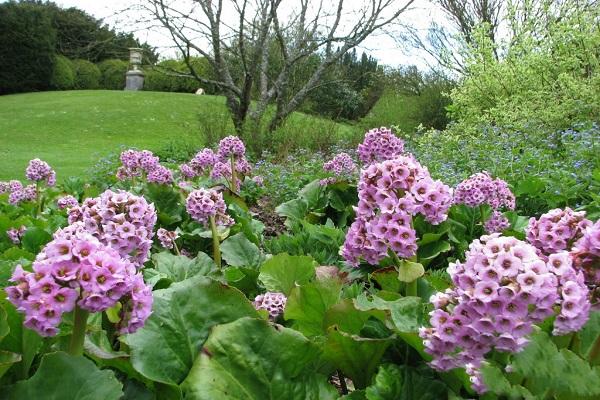
Varieties of badan
To breed cultivated varieties of badan, wild species were used. Among the varieties that have earned the recognition of plant growing lovers, the following specimens below are noted.
Thick-leaved
This badan grows in Altai, Mongolia and Sayan. This evergreen planting is almost 60 centimeters high. It forms leathery sheet plates with a glossy surface. They have a round shape and are formed into a tight rosette. According to external data, numerous flowers are very similar to bells.
The color of the paniculate inflorescence is predominantly pale pink, but it can also be lilac. The flowering phase begins early and falls on the end of April-June. The thick-leaved retains its attractive appearance throughout the summer due to juicy leaves.
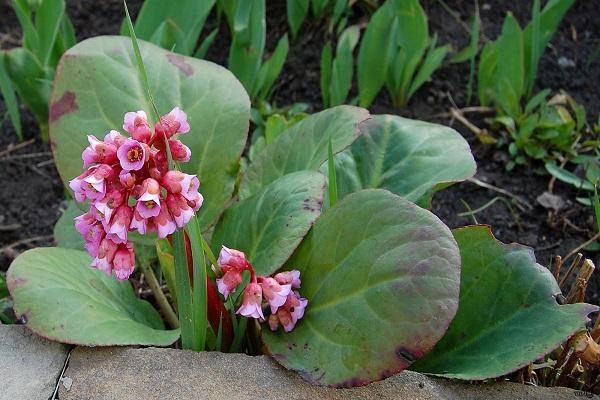
It is noteworthy that badan does not lose its foliage color during the winter period, which only increases its popularity among landscape designers..
Hearty
This variety of bergenia medicinal reaches a height of only 35 centimeters, but these indicators may differ depending on the place of growth. The color of the original inflorescences can also vary, from pink to deep purple. Badan is appreciated due to its lush heart-shaped leaf plates. The plant can please with its unusual flowering several times during the year.

Pacific
This large representative of the Stonefragment family produces a reddish peduncle on which small pink bells are formed. They often stand out with a lilac tint. The height of the badan is no more than 50 centimeters.
The leaf plates are leathery in the shape of an ellipse, the color is dark green, but in the fall it changes to red. Badan does not cause difficulties in cultivation, blooms in spring, fruit ripens in June-August.
Schmidt
Badan Schmidt is especially popular in Europe. It is chosen for its elliptical leaves with a matte surface. They are dark green in color, grow up to 25 centimeters in length and up to 15 centimeters in width. They have serrated edges and elongated petioles. They attract attention with the unusual structure of the leaf plates, where projections similar to the wings are formed near the base of the petiole.
The color of the flowers is bright, pink-scarlet. They are collected in dense inflorescences. In autumn, the leaf mass acquires a dark red, almost ink tint.
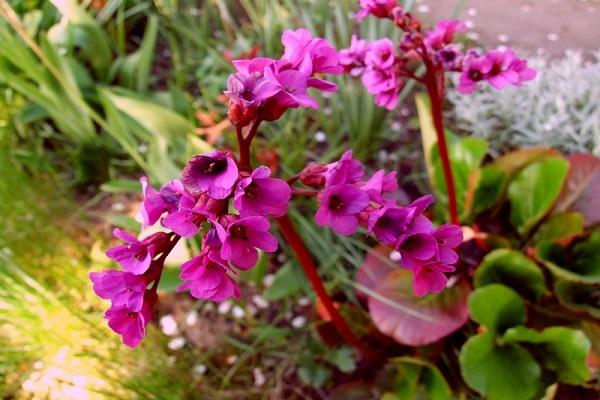
Strechi
This miniature berry is distinguished by large peduncles, their height reaches 30 centimeters. It is noteworthy that at one time both snow-white and pink flowers can be on it. The flowering phase begins in May.
The plant, which is native to the Pamirs and the Himalayas, forms leaf plates with a glossy surface. They have an oblong shape and scalloped edges. They are 10 centimeters long and 5 centimeters wide.Badan has established itself as a frost-resistant and resistant to adverse environmental factors plant.
Ciliated
This variety grows in Tibet and the Himalayas. It has rounded leaf plates, which are covered with small bristles (pile). They are actively growing in width, their length reaches 35 centimeters. The color is green, and in autumn it is reddish-bronze. There are rounded teeth on the edges.
On high peduncles (30 centimeters), numerous large-sized flowers are formed. They are painted white or pink, thinning the pleasant smell. A plant is grown both for cutting and for decorating a personal plot. Do not worry if the leaves fall off in winter, this happens at a temperature of -18 degrees.
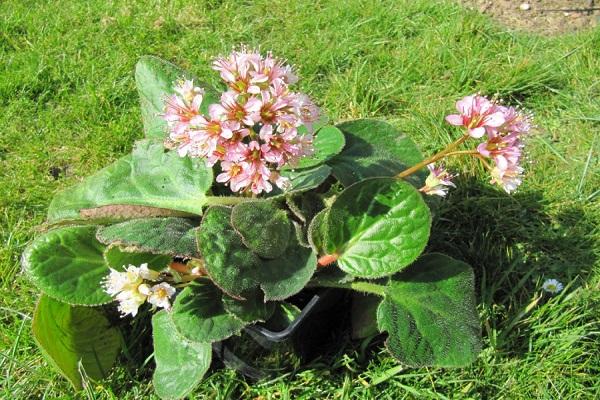
Hybrid crop varieties
Abendglut
Plant height does not exceed 30 centimeters. Closer to the autumn of a rich green color, the leaves become a bronze-brown hue. Semi-double flowers are purple in color.
Bressingham white
Badan of this variety does not leave anyone indifferent, its white flowers instantly attract the eye. Plant height up to 30 centimeters.
Ballawley
The bush grows up to only 40 centimeters. It is effectively decorated with pinkish-red flowers. The plant fits perfectly into any composition and does not require special care.
Baby doll
The hybrid has a slow growth rate. Its flowers range from pale pink to flesh-colored. The plant is positioned as highly decorative and unpretentious to growing conditions.
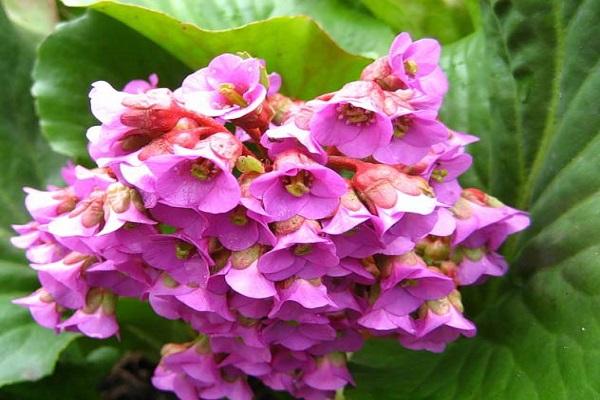
Glockenturm
Badan reaches a height of almost 50 centimeters. The leaf plates are slightly wavy, have a rich emerald green color. Attracts attention with pink buds and a pleasant scent.
Morgenrote
The hybrid plant forms lush inflorescences, which consist of beautiful pink buds. It blooms twice: in spring and autumn.
Scheekoenigin
The decorative culture does not exceed 50 centimeters in height. The leaf plates have wavy edges and a green color. Flowers gradually turn from white to pink.
Eroica
The bush forms crimson-red inflorescences and a green leaf mass. With the arrival of autumn, she changes her color to purple, which looks very original.

Silberlicht
The plant reaches a height of 40 centimeters. The color of the flowers is white, there is a pinkish tint. The bush is tender and sophisticated.
Sunningdale
Badan grows up to 40 centimeters. Its distinctive feature is its dark purple flowers.
How to plant and grow a culture
For planting badan, it is worth choosing sunny meadows, where it will delight you with its flowering for a long time. Planting in the shade is also possible, but it will grow into a carpet. The soil should not be scanty, moderately fertile and free of weeds.
The main thing is that there is a expanded clay drainage cushion in the pit. The distance between the bushes should be at least 40 centimeters.

The nuances of caring for badan
In order to avoid drying out of the soil under the bushes, it is necessary to use mulch from sawdust, crushed bark, leaf humus. Irrigation should be abundant and regular. After the flower stalks have faded, they are cut off.
Badan is an ornamental culture that does not require special conditions and gives the site a certain exoticism. The main thing is to prevent waterlogging of the soil and mulch its roots.


